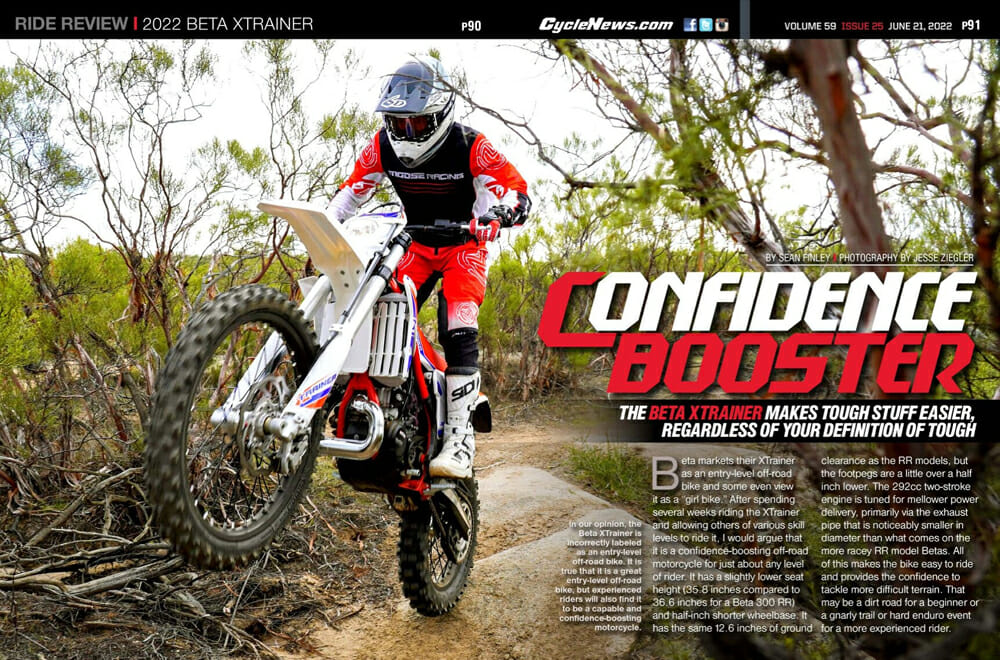Sean Finley | June 25, 2022
Beta markets their XTrainer as an entry-level off-road bike and some even view it as a “girl bike.” After spending several weeks riding the XTrainer and allowing others of various skill levels to ride it, I would argue that it is a confidence-boosting off-road motorcycle for just about any level of rider.
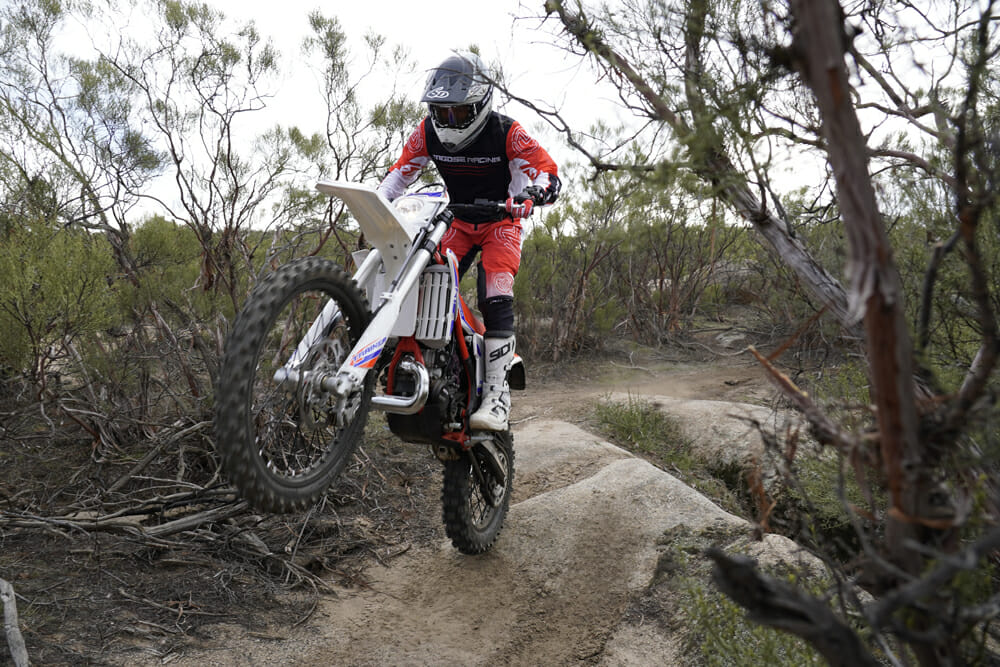 In our opinion, the Beta XTrainer is incorrectly labeled as an entry-level off-road bike. It is true that it is a great entry-level off-road bike, but experienced riders will also find it to be a capable and confidence-boosting motorcycle.
In our opinion, the Beta XTrainer is incorrectly labeled as an entry-level off-road bike. It is true that it is a great entry-level off-road bike, but experienced riders will also find it to be a capable and confidence-boosting motorcycle.
Photography by Jesse Ziegler
It has a slightly lower seat height (35.8 inches compared to 36.6 inches for a Beta 300 RR) and half-inch shorter wheelbase. It has the same 12.6 inches of ground clearance as the RR models, but the footpegs are a little over a half inch lower. The 292cc two-stroke engine is tuned for mellower power delivery, primarily via the exhaust pipe that is noticeably smaller in diameter than what comes on the more racey RR model Betas. All of this makes the bike easy to ride and provides the confidence to tackle more difficult terrain. That may be a dirt road for a beginner or a gnarly trail or hard enduro event for a more experienced rider.
Like the Beta RR models, the 292cc two-stroke utilizes a six-speed transmission and includes a two-position power switch (Sun and Rain modes). It utilizes a 36mm Keihin PWK carburetor and oil-injection system, so you don’t need to mix oil in the fuel. This simple feature is really appreciated as you don’t need to have separate gas cans for four-stroke bikes with friends or family.
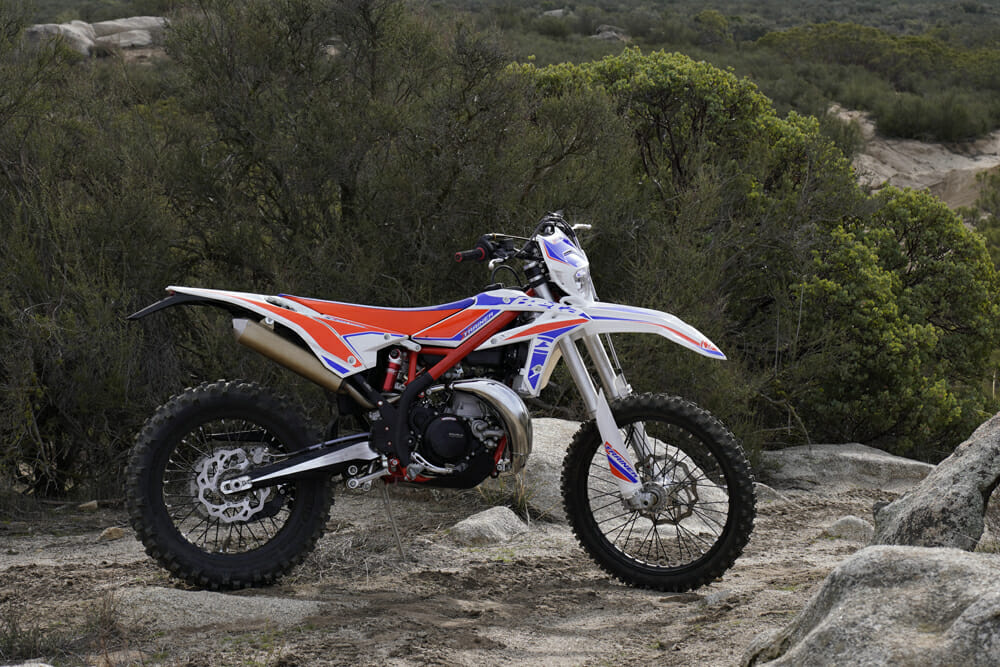 The XTrainer has about an inch lower seat height and half-inch shorter wheelbase and the footpegs are also about a half-inch lower than Beta’s more racey RR models. That does not sound like much, but that all adds up to a much easier to ride bike.
The XTrainer has about an inch lower seat height and half-inch shorter wheelbase and the footpegs are also about a half-inch lower than Beta’s more racey RR models. That does not sound like much, but that all adds up to a much easier to ride bike.
The clutch is a hydraulically controlled diaphragm style and has an easy pull. The electric start with optional backup kickstarter will be appreciated by riders of all levels. It also includes an aluminum kickstand that tucks up nicely out of the way and has a large foot for soft dirt. A headlight and enduro-style computer that includes speed, odometer, two separate tripmeters and an hour meter are also great standard features. The Nissin brakes are like those found on Honda motocross models just a few years ago.
The Ollé suspension has 10.6 inches of front- and rear-wheel travel, which is about an inch less than the RR model Beta’s. They are an open-cartridge fork with adjustable rebound and preload. The rear shock is a steel-body unit that includes compression, rebound and preload adjustability. The shock and forks are different than the components found on the RR models.
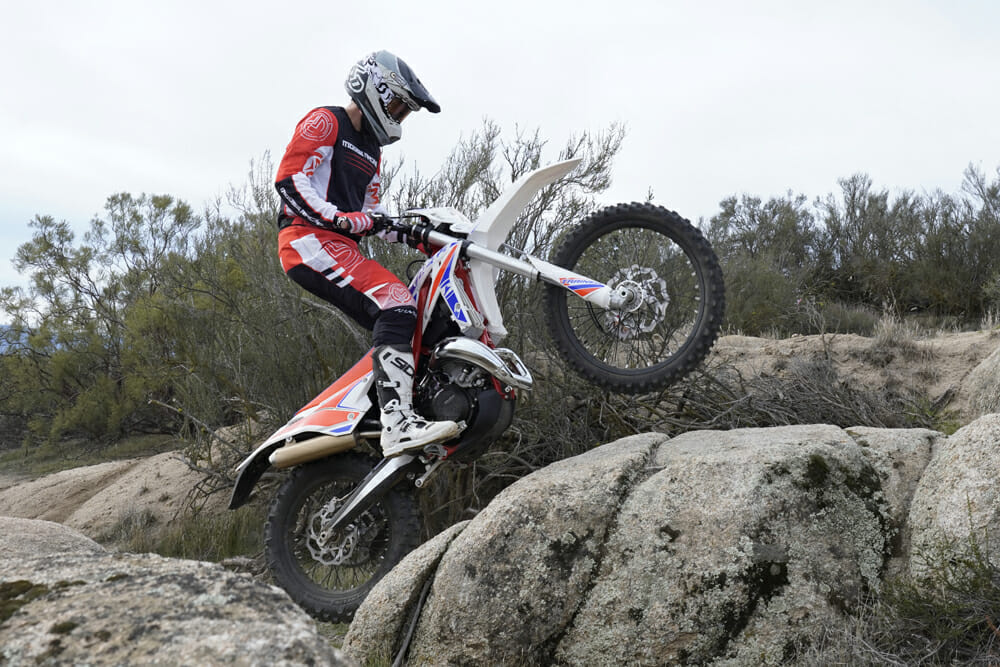 The XTrainer comes with a lot of features including a headlight, enduro computer, quality kickstand, electric starting, oil-injection, skid plate and radiator fan. It is ready for the tough stuff.
The XTrainer comes with a lot of features including a headlight, enduro computer, quality kickstand, electric starting, oil-injection, skid plate and radiator fan. It is ready for the tough stuff.
The XTrainer comes equipped with a plastic skid plate and radiator fan, much needed items for difficult trails. You will want to add some handguards and likely other protective items such as radiator and disc guards if you are hitting the really difficult terrain.
One other feature to point out on the XTrainer is the suggested retail price of $7999. That is $1700 less than the Beta RR models and $2000 less than other high-performance two-stroke off-road bikes.
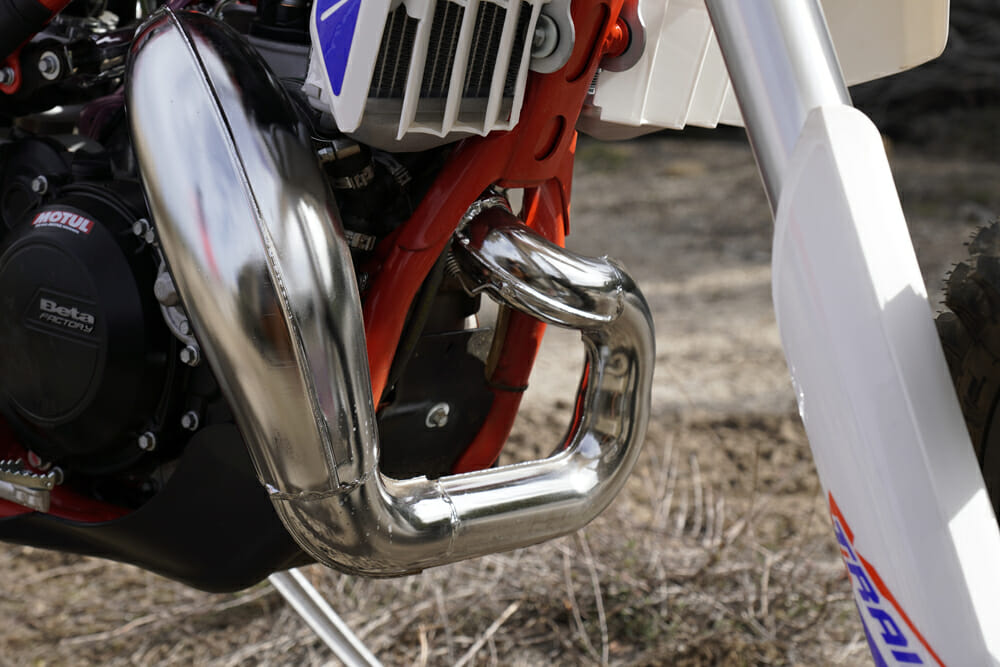 The motor is similar to the 292cc two-stroke found in the Beta RR models but is tuned for mellower power delivery that contributes to the rideability. It is still plenty fast if you want to open it up.
The motor is similar to the 292cc two-stroke found in the Beta RR models but is tuned for mellower power delivery that contributes to the rideability. It is still plenty fast if you want to open it up.
2022 Beta XTrainer | Riding Time
As soon as you throw your leg over the seat, you will notice the lower seat height. One inch does not sound like a lot, but that, combined with lower footpegs, immediately boost your confidence with a lower center of gravity. Combine that with the mellow power delivery that will tractor through the slowest and most difficult terrain, and you will find yourself aiming for obstacles that you would likely avoid on other motorcycles.
VIDEO | Beta X Trainer Ride Review
The engine is a bit mellower than the Beta RR models as well as the alternative two-stroke 300s available from other manufacturers, but it is plenty fast for most conditions and the six-speed transmission will allow you to carry plenty of speed in open terrain. In fact, it will comfortably cruise at 75 mph. The Keihin carburetor is jetted well for a wide range of riding conditions. Some will argue that the more high-tech fuel injected (TPI) bikes from KTM/Husqvarna/GasGas run better but a lot of riders still prefer the performance of a carburetor. None of our test riders had any complaints about the carburetion.
In addition to the two-position map switch, which provides a small but noticeable difference in the power delivery, you can change the power delivery by adjusting the power valve with an Allen wrench.
The Beta has a counter-balancer to reduce the vibration and it is a significant improvement over older generation two-strokes but still has a little more buzz than you will find with the KTM/Husqvarna/GasGas 300 two-strokes. It is a small difference that is only noticeable when riding the bikes back-to-back, but it is worth noting.
The hydraulic clutch was flawless with good feel and no fading ever detected.
The 2.1-gallon fuel tank is a little smaller than the 2.5-gallon stock tanks on the RR models. This could be a little limiting if you like to ride long distances. If that is a concern, Beta offers a 2.9-gallon aftermarket IMS tank. It’s also offered in translucent, which is much easier to top off without over filling compared to the stock black tank.
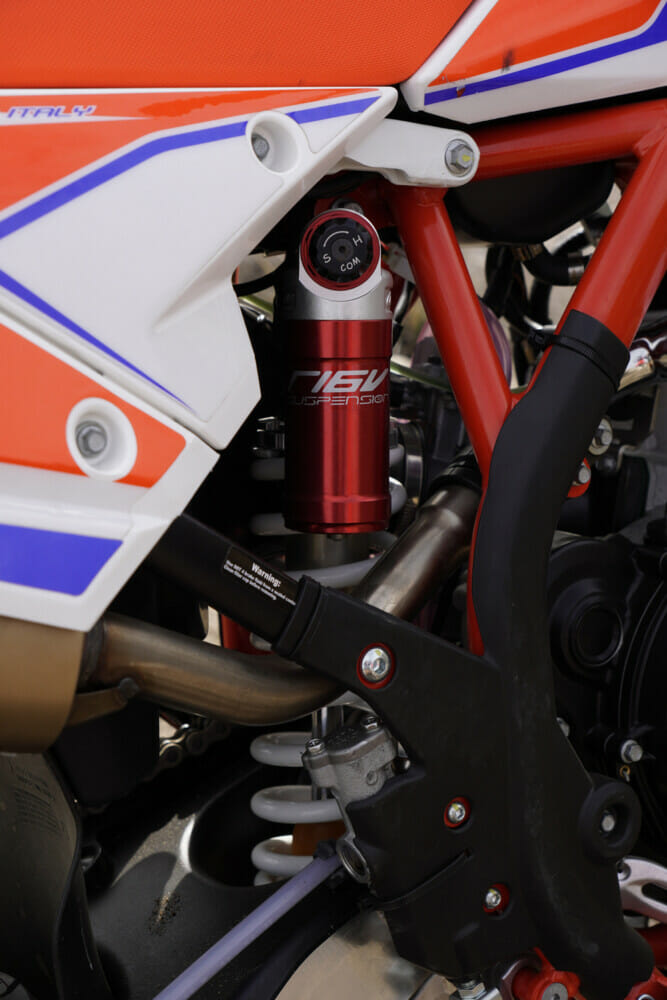 The Ollé suspension has 10.6 inches of travel front and rear, an inch less than the Beta RR models. That contributes to the lower seat height, part of what makes it great for trail riding.
The Ollé suspension has 10.6 inches of travel front and rear, an inch less than the Beta RR models. That contributes to the lower seat height, part of what makes it great for trail riding.
The Nissin brakes perform well, in fact, some riders thought the front brake may be a little too powerful for newer riders, but more experienced riders will love the stopping power.
The Ollé suspension is a lower grade than the units found on the RR models, but the outright performance is not significantly different despite the reduced travel. The forks in particular need a bit of break-in time to work properly but are still a bit harsh on small sharp hits. But they work pretty good at slower speeds, even in roots and rocks. If you are a fast, heavy and/or aggressive rider, you will probably find that the suspension performance is lacking, but it is sufficient for aggressive trail riding for most riders. The Betas come standard with Michelin Enduro Medium tires, which have stiff sidewalls that contribute to the harsh initial suspension travel. Michelin and other brands make better off-road options that will be an upgrade in traction and compliance once you burn through the stock tires.
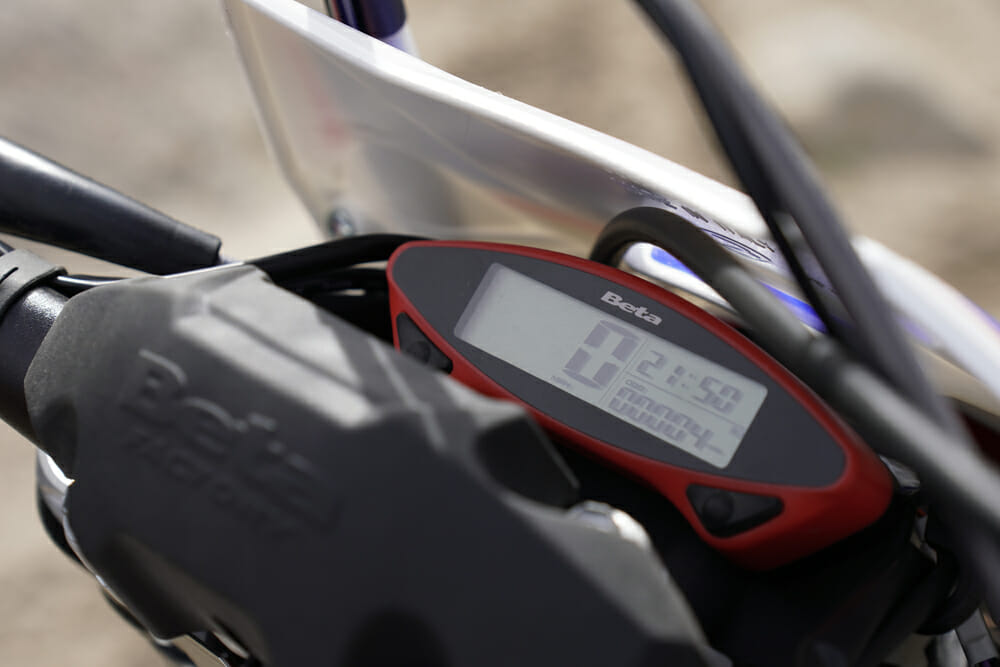 The XTrainer comes with a slick enduro meter.
The XTrainer comes with a slick enduro meter.
For single-track trails, the low seat height and center of gravity contribute to a great performing chassis. In fact, single-track trails and tough terrain is where this bike really shines for experienced riders. The whole package of chassis, brakes and power delivery is in the sweet spot in these conditions.
Retired “Old Guy” Ray Conway was one of our test riders. He has ridden off-road for most of his life and, at 5-foot-8, he appreciated the size and rideability of the XTrainer. “That is a dirt-bike career-extending motorcycle. It is so easy to ride. It makes hard trails simple,” Conway said after a day of riding.
We also interviewed some XTrainer owners. Mark Wood is 6-feet tall and 185 pounds: “I wanted to slow it down a little and liked the idea of a smaller bike that I could throw around easier on the trails. I have owned the bike for over a year and really enjoy it. I like the power being a little more like a trials bike. The suspension finds its limit on whoops in the desert, but I am not trying to race, so it is good enough to enjoy the ride. The only issue I have had is a wire that controls the oil-injection system came apart, and I learned of some other owners having similar wiring harness issues via some of the online forums.”
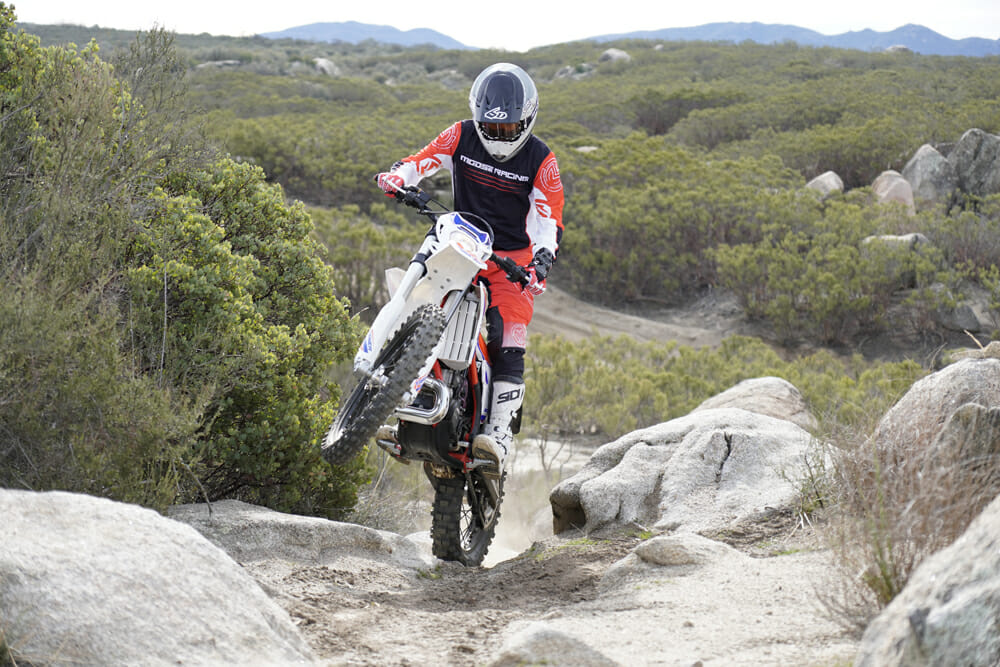 At just $7999, you get a lot for your money with the XTrainer.
At just $7999, you get a lot for your money with the XTrainer.
Nathan Glinski is a 33-year-old that lives in Knoxville, Tennessee, who grew up riding trials. He owns a 2017 XTrainer and previously owned a Beta 250 RR and KTM 300 XCW. “I bought the XTrainer because being 5-foot-9,” I felt that the lower seat height would help me ride the tough trails we ride around here. I have finished four Tennessee Knockout Hard Enduro events in the amateur class and made it through both Saturday races each time. You can feel the difference in the size. I haven’t had any problems with the bike, it has been very reliable.”
Beginner riders may compare this to entry-level four-strokes that are a couple thousand dollars less expensive. Those bikes are over 60 pounds heavier than the XTrainer, which weighs in at 238 pounds with a full fuel tank ready to ride. The weight and lower-quality suspension, brakes and engine performance put those entry-level four-strokes in a different class that can be more difficult to ride.
If you are an experienced rider who is comparing this with the Beta RR, Sherco, Yamaha or KTM/Husqvarna/GasGas two-stroke off-road models, you will be surprised at how much easier the XTrainer is to ride, especially in difficult terrain. This is especially true if you are relatively short, but it doesn’t give up much in terms of pure speed. If you are a talented rider and in great shape, you can probably take advantage of the additional suspension travel and engine performance of the RR and alternative brand off-road bikes but for most off-road riders, the XTrainer will likely improve your confidence and fun factor. CN
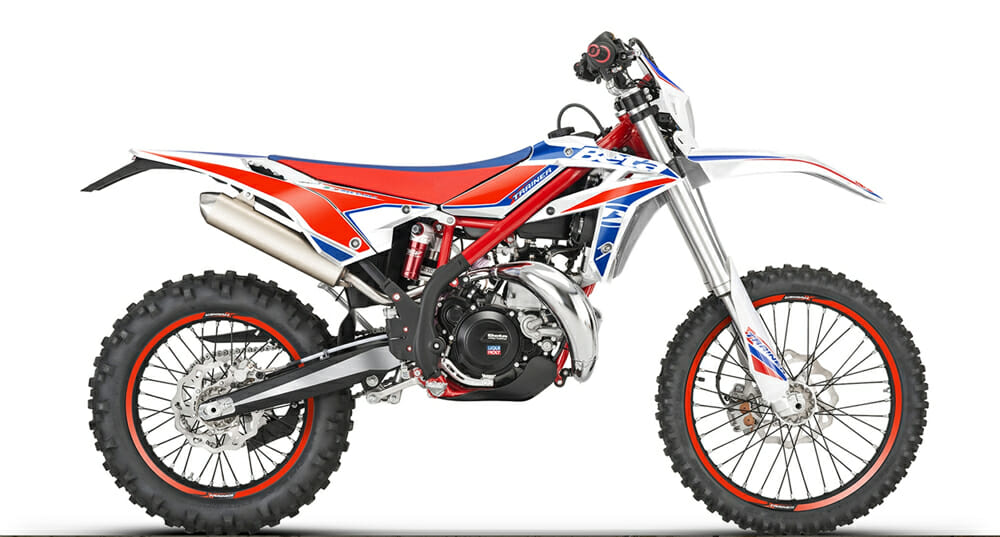
2022 Beta XTrainer Specifications
| MSRP |
$7999 |
| Engine Type |
2-stroke, single, adjustable power-valve |
| Cooling system |
Liquid |
| Displacement |
292.3cc |
| Bore x Stroke |
73 x 69.9mm |
| Starting System |
Electric (optional kickstart backup) |
| Lubrication |
Oil injection |
| Fueling |
Keihin PWK 36mm |
| Transmission |
6-speed |
| Clutch |
Wet multi-disc diaphragm-style clutch with hydraulic actuation |
| Frame |
Molybdenum steel perimeter double-cradle-type |
| Front Suspension |
Ollé 43mm inverted fork with adjustable damping |
| Rear Suspension |
Ollé steel body with adjustable rebound and compression |
| Front-Wheel Travel |
10.6 in |
| Rear-Wheel Travel |
10.6 in |
| Front Wheel |
21 in. |
| Rear Wheel |
18 in. |
| Front Tire: |
90/90 x 21 Michelin Enduro Medium |
| Rear Tire: |
140/80 x 18 Michelin Enduro Medium |
| Front Brake |
260mm, Nissin master cylinder and caliper |
| Rear Brake |
240mm, Nissin master cylinder and caliper |
| Seat Height |
35.8 in. |
| Ground Clearance |
12.6 in. |
| Wheelbase |
57.8 in. |
| Fuel Capacity |
2.25 gal. |
| Weight (wet, full fuel) |
238 lbs. |
